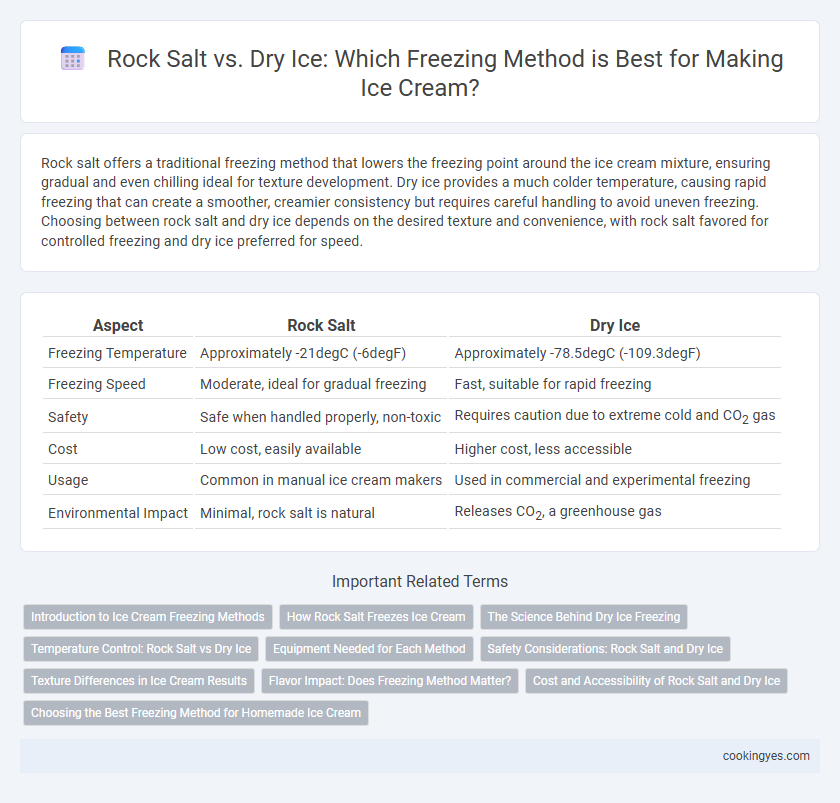Rock salt offers a traditional freezing method that lowers the freezing point around the ice cream mixture, ensuring gradual and even chilling ideal for texture development. Dry ice provides a much colder temperature, causing rapid freezing that can create a smoother, creamier consistency but requires careful handling to avoid uneven freezing. Choosing between rock salt and dry ice depends on the desired texture and convenience, with rock salt favored for controlled freezing and dry ice preferred for speed.
Table of Comparison
| Aspect | Rock Salt | Dry Ice |
|---|---|---|
| Freezing Temperature | Approximately -21degC (-6degF) | Approximately -78.5degC (-109.3degF) |
| Freezing Speed | Moderate, ideal for gradual freezing | Fast, suitable for rapid freezing |
| Safety | Safe when handled properly, non-toxic | Requires caution due to extreme cold and CO2 gas |
| Cost | Low cost, easily available | Higher cost, less accessible |
| Usage | Common in manual ice cream makers | Used in commercial and experimental freezing |
| Environmental Impact | Minimal, rock salt is natural | Releases CO2, a greenhouse gas |
Introduction to Ice Cream Freezing Methods
Rock salt and dry ice are two common substances used in traditional ice cream freezing methods, each offering unique temperature control and freezing speeds. Rock salt lowers the freezing point of ice, creating a slushy mixture that surrounds the ice cream container, enabling gradual and even freezing. Dry ice, composed of solid carbon dioxide, offers much faster freezing at temperatures around -78.5degC, which can produce smoother textures by rapidly freezing the mixture and reducing ice crystal formation.
How Rock Salt Freezes Ice Cream
Rock salt lowers the freezing point of ice, allowing the ice cream mixture to freeze more efficiently by creating a colder environment around the container. When mixed with ice, rock salt draws heat from the ice cream mixture, causing it to solidify evenly and quickly. This traditional method ensures a smooth texture by preventing large ice crystals from forming during the freezing process.
The Science Behind Dry Ice Freezing
Dry ice freezes ice cream by rapidly lowering the temperature through sublimation, turning directly from solid to gas at -78.5degC (-109.3degF), which creates intense cold without leaving liquid residue. This rapid freezing process forms smaller ice crystals, resulting in smoother and creamier ice cream texture compared to traditional rock salt methods that slowly lower temperatures around -20degC (-4degF). The chemical reaction between dry ice and moisture produces carbon dioxide gas, enhancing safety and efficiency in freezing while maintaining product consistency.
Temperature Control: Rock Salt vs Dry Ice
Rock salt lowers the freezing point of ice to around -21degC, offering gradual and stable temperature control ideal for traditional hand-churned ice cream. Dry ice, with a temperature of approximately -78.5degC, provides rapid freezing, resulting in smoother texture but requires careful handling to prevent over-freezing or freezer burn. Precise temperature monitoring is crucial when using dry ice to maintain optimal consistency without compromising cream quality.
Equipment Needed for Each Method
Rock salt requires a mixing container, an ice bucket, and salt crystals to lower the freezing point, making it effective for traditional ice cream makers. Dry ice demands insulated gloves, a sturdy cooler or container, and crushed dry ice to rapidly freeze the mixture without mechanical stirring. Both methods differ in equipment complexity and cooling speed, impacting ease of use and final texture.
Safety Considerations: Rock Salt and Dry Ice
Rock salt, widely used in traditional ice cream making, poses minimal risk when handled properly but can cause skin irritation or burns if direct contact occurs due to its coarse texture and freezing temperature. Dry ice, composed of solid carbon dioxide, requires careful handling with insulated gloves to prevent frostbite and should never be enclosed in airtight containers to avoid explosion hazards from gas buildup. Both freezing agents demand safety precautions to minimize injury risks during ice cream preparation.
Texture Differences in Ice Cream Results
Rock salt creates a slower freezing process that forms larger ice crystals, resulting in a creamier and smoother ice cream texture. Dry ice cools rapidly, producing smaller ice crystals that can create a denser, sometimes icier texture if not churned properly. The choice between rock salt and dry ice impacts ice crystal size, directly influencing the final mouthfeel and softness of homemade or artisanal ice cream.
Flavor Impact: Does Freezing Method Matter?
Rock salt absorbs moisture and creates a slower, gentler freezing process that preserves the creamy texture and rich flavor of ice cream. Dry ice freezes ice cream rapidly, resulting in smaller ice crystals but risking flavor dilution due to quicker freezing. Choosing the freezing method affects the final flavor intensity and texture, with rock salt offering a traditional taste experience and dry ice providing smoother but sometimes less nuanced flavors.
Cost and Accessibility of Rock Salt and Dry Ice
Rock salt is a cost-effective and widely accessible option for freezing ice cream, commonly available in grocery and hardware stores at low prices, making it ideal for home use and small-scale production. Dry ice, though capable of achieving lower temperatures rapidly, is generally more expensive and requires special handling and storage due to its sublimation properties, limiting its accessibility for everyday users. Rock salt's affordability and ease of procurement make it a preferred choice for traditional ice cream freezing methods, while dry ice is often reserved for commercial or specialized applications.
Choosing the Best Freezing Method for Homemade Ice Cream
Rock salt and dry ice both offer effective freezing methods for homemade ice cream, but rock salt paired with ice provides a more controlled and consistent freezing environment. Rock salt lowers the melting point of ice, enabling the cream mixture to freeze slowly, which helps create a smoother texture by minimizing ice crystal formation. Dry ice freezes ice cream rapidly, beneficial for quick results but may produce a grainier texture due to faster freezing and uneven temperature distribution.
Rock Salt vs Dry Ice for Freezing Method Infographic

 cookingyes.com
cookingyes.com